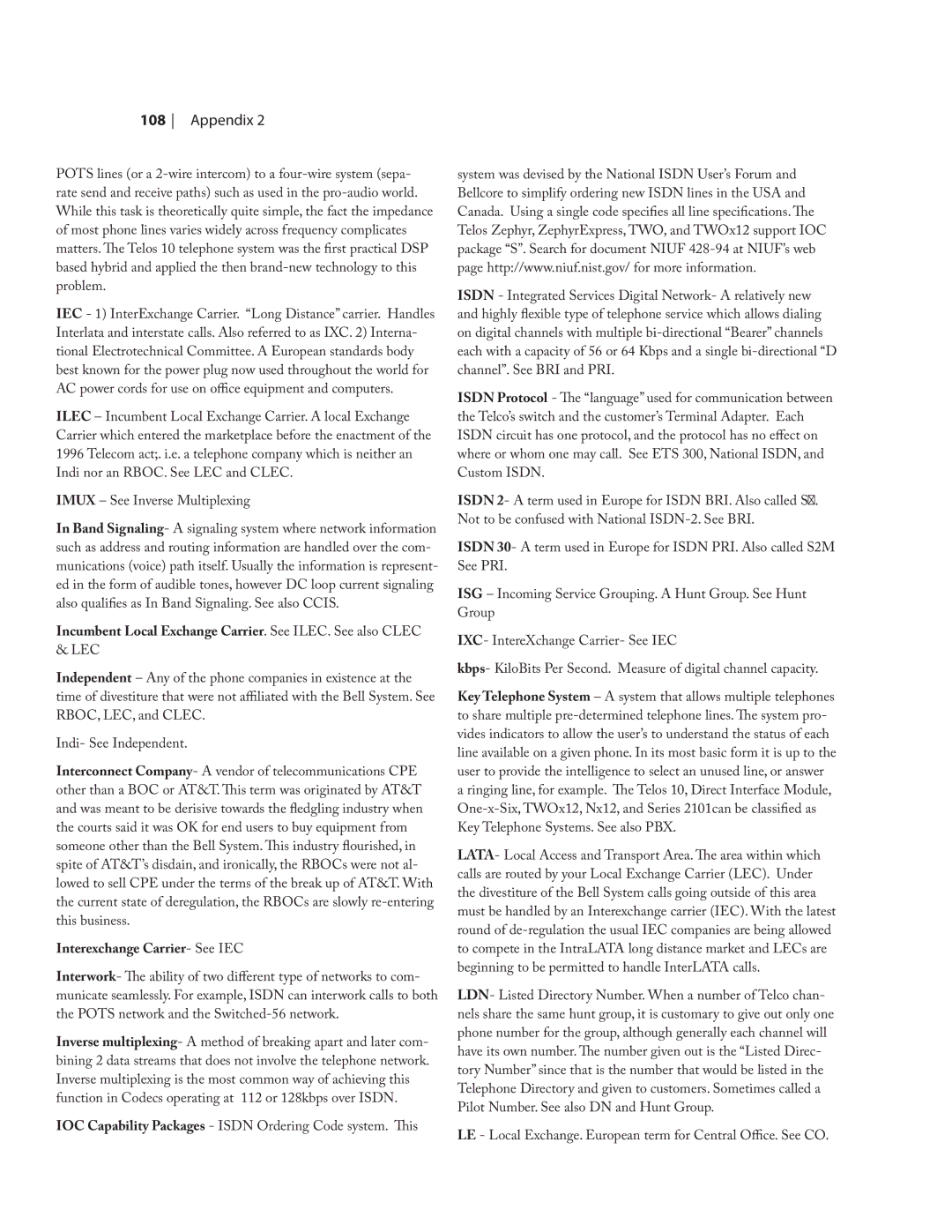108 Appendix 2
POTS lines (or a
IEC - 1) InterExchange Carrier. “Long Distance” carrier. Handles Interlata and interstate calls. Also referred to as IXC. 2) Interna- tional Electrotechnical Committee. A European standards body best known for the power plug now used throughout the world for AC power cords for use on office equipment and computers.
ILEC – Incumbent Local Exchange Carrier. A local Exchange Carrier which entered the marketplace before the enactment of the 1996 Telecom act;. i.e. a telephone company which is neither an Indi nor an RBOC. See LEC and CLEC.
IMUX – See Inverse Multiplexing
In Band Signaling- A signaling system where network information such as address and routing information are handled over the com- munications (voice) path itself. Usually the information is represent- ed in the form of audible tones, however DC loop current signaling also qualifies as In Band Signaling. See also CCIS.
Incumbent Local Exchange Carrier. See ILEC. See also CLEC & LEC
Independent – Any of the phone companies in existence at the time of divestiture that were not affiliated with the Bell System. See RBOC, LEC, and CLEC.
Indi- See Independent.
Interconnect Company- A vendor of telecommunications CPE other than a BOC or AT&T. This term was originated by AT&T and was meant to be derisive towards the fledgling industry when the courts said it was OK for end users to buy equipment from someone other than the Bell System. This industry flourished, in spite of AT&T’s disdain, and ironically, the RBOCs were not al- lowed to sell CPE under the terms of the break up of AT&T. With the current state of deregulation, the RBOCs are slowly
Interexchange Carrier- See IEC
Interwork- The ability of two different type of networks to com- municate seamlessly. For example, ISDN can interwork calls to both the POTS network and the
Inverse multiplexing- A method of breaking apart and later com- bining 2 data streams that does not involve the telephone network. Inverse multiplexing is the most common way of achieving this function in Codecs operating at 112 or 128kbps over ISDN.
IOC Capability Packages - ISDN Ordering Code system. This
system was devised by the National ISDN User’s Forum and Bellcore to simplify ordering new ISDN lines in the USA and Canada. Using a single code specifies all line specifications. The Telos Zephyr, ZephyrExpress, TWO, and TWOx12 support IOC package “S”. Search for document NIUF
ISDN - Integrated Services Digital Network- A relatively new and highly flexible type of telephone service which allows dialing on digital channels with multiple
ISDN Protocol - The “language” used for communication between the Telco’s switch and the customer’s Terminal Adapter. Each ISDN circuit has one protocol, and the protocol has no effect on where or whom one may call. See ETS 300, National ISDN, and Custom ISDN.
ISDN 2- A term used in Europe for ISDN BRI. Also called S. Not to be confused with National
ISDN 30- A term used in Europe for ISDN PRI. Also called S2M See PRI.
ISG – Incoming Service Grouping. A Hunt Group. See Hunt Group
IXC- IntereXchange Carrier- See IEC
kbps- KiloBits Per Second. Measure of digital channel capacity.
Key Telephone System – A system that allows multiple telephones to share multiple
LATA- Local Access and Transport Area. The area within which calls are routed by your Local Exchange Carrier (LEC). Under the divestiture of the Bell System calls going outside of this area must be handled by an Interexchange carrier (IEC). With the latest round of
LDN- Listed Directory Number. When a number of Telco chan- nels share the same hunt group, it is customary to give out only one phone number for the group, although generally each channel will have its own number. The number given out is the “Listed Direc- tory Number” since that is the number that would be listed in the Telephone Directory and given to customers. Sometimes called a Pilot Number. See also DN and Hunt Group.
LE - Local Exchange. European term for Central Office. See CO.
